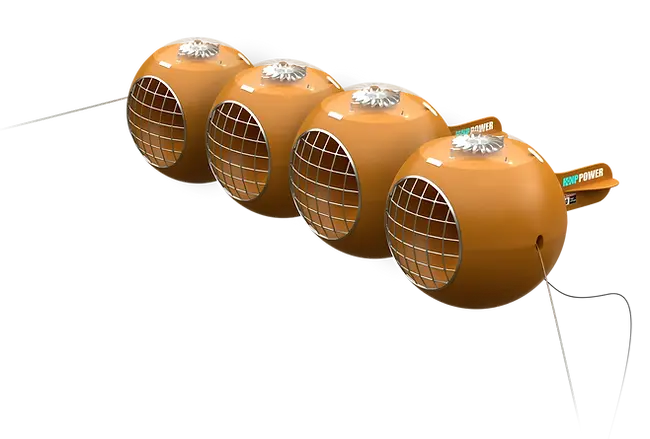
HYDROPOWER GENERATION
FOR INDIVIDUAL HOMES
Our new mini-hydropower turbine can work in low velocity and small rivers. It requires no outside source of power other than the kinetic energy of flowing water. The turbine does not require any professional installation. Read more about turbine ->

FULLY
SUSTAINABLE
Relies on a completely renewable source of energy.
QUICK
INSTALLATION
Easy and
effortless setup
process.
RELIABLE
AND PORTABLE
ALL-IN-ONE unit significantly
reduces maintenance costs and can operates well in the cold northern climate
ECO / LANDSCAPE
FRIENDLY
No emissions,
no noise or pollution!
Turbine does not affect natural landscape.
WHO WE HELP

More than 6.3 million Canadians are living in rural areas with fewer than 1,000 inhabitants and a population density below 400 people per square kilometer.
Rural Canada is highly diverse. By any measure, socio-economic, cultural, and environmental characteristics, rural areas are found at both extremes of the distribution. For instance, rural communities of Canada are found among the most affluent and the most disadvantaged.
The importance of energy lies in its wide applicability and indispensability. Energy has the power to help bring up the disadvantaged and even out the playing field. The social and economic development of modern societies is based on energy. Energy is the key contributor to poverty relief, the increase in human welfare, and the improvement of living standards. Energy is placed in the middle of the triangle among nature, society, and economy; it is treated as an essential element of global progress. Growth of population and economics dictates the increasing demand of energy every year.
Access to energy is even more important in rural communities. Canada is home to many “off-grid” communities, permanent or long-term (5 years or more) settlements and remote communities with at least 10 dwellings not connected to the North American electrical grid nor the natural gas network.
Remote communities are not connected to the main North American electricity grid and do not receive the benefits that 99% of the Canadian population take for granted, such as reliable and affordable electricity. They rely solely on locally generated electricity, which typically comes from diesel-powered generators. This limits the potential growth of these communities and can have adverse environmental impacts.
There are currently 292 Canadian remote communities with a total population of approximately 194,281 people. These communities include Aboriginal and non-Aboriginal settlements, villages, or cities as well as long-term commercial outposts and camps for mining, fishing, and forestry activities.
Many of the remote communities of Canada have access to water sources which can be used to power sustainable development. We can deploy our solution in a cost-effective way to create renewable hydro power to support remote communities. The savings in those communities as a result from deploying our system could lead job creation, local skill development, and increased community self-reliance.
The economies of remote communities have traditionally been based on local resources such as fishing, hunting, and trapping but modernization, electricity, heat, and mechanical transportation have been brought to these communities using technology and fuel imported from the south at great costs. It is clear that in the near term, these communities will continue to rely on fossil fuels; however, it is possible to reduce their dependence and increase their reliance on local energy resources. We can help decrease pollution and contribute to their economic development through sustainable energy supply.
Clean power in remote communities can bring about:

SOCIAL IMPACT / ENVIRONMENTAL IMPACT
Concerns raised by diesel generation versus sustainable power generation
Environmental Concerns
-
Burning large amounts of diesel produce substantial greenhouse gas emissions. This contributes to climate change which negatively affects Northern communities.
-
Fuel must be transported long distances by airplane, truck, or barge, leading to a greater risk of fuel spills.
-
The transportation of fuel by trucks on winter roads impacts the environment negatively.
-
Fuel spills may take place while the fuel is being transported and stored, posing environmental risks. Fuel tank leaks contaminate soil and groundwater.
Social Concerns
-
Generators can be noisy and disruptive, especially in quiet, remote communities.
-
Emissions from diesel generators could contribute to health problems in community members.
-
Black-outs can occur if diesel generators break down or are not properly maintained. This can be dangerous in cold, remote locations.
-
Remote communities can become very dependent on outside sources to provide fuel for their power.
Economic Concerns
-
Cold, northern locations have a high demand for diesel and heating fuel which contributes to high energy expenditures.
-
Diesel fuel must be flown in, shipped in, or driven in on winter roads which leads to high transportation costs, which contributes to high energy expenditures.
-
High energy costs take away from the communities’ funds to invest in other infrastructure networks that makes the community stagnant.
Diesel is a non-renewable resource; therefore the price of diesel fuel will likely continue to fluctuate in the future, based on overall supply and demand. The high cost of energy and energy supply issues in off-grid communities can deter new businesses, thus limiting future economic opportunities in off-grid communities.

DIESEL POWER
GENERATOR
VS
HNP Power
DIFFERENT RIVERS – ONE SOLUTION

WIDE LOW-VELOCITY RIVER
The mini hydropower turbine is installed close to the riverbank and attached to an anchor at the bottom or to nearby structures on land

A SMALL RIVER OR CREEK
A pipe is used to collect and direct the water flow to the device inlet, the water drop should be at least 1.5m, to maintain the minimal pressure

BATTERY
OF DEVICES
It is possible to combine a series of turbines to generate power for several homes or a neighborhood
Several mini-hydropower turbines could be installed as a battery and operate together to generate more power.
This can easily provide great savings compared to gas-powered generators
-
Environmentally friendly
-
Doesn’t require permanent structures
-
Sustainable, no impact on river ecosystem and fauna







